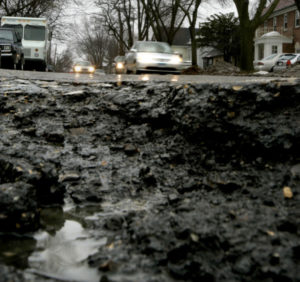
The spring freeze-and-thaw cycle of pavements accelerates the formation of potholes. (Photo credit: State Journal archives)
Many drivers probably consider early spring to be pothole season.
A pothole is a structural failure in a road surface.
Potholes result from a combination of traffic and water in the underlying soil.
Many roadways are constructed in layers.
The top layer is water resistant and curved to drain water off the road and onto the shoulder.
Underlying the layer we drive on is gravel and soil. Water can seep below the top surface into the underlying materials. Water weakens the soil that lies beneath the pavement, and then stresses due to traffic weaken the pavement and with time, and heavy loads, the pavement breaks up.
We live in an area that experiences freezing and thawing, particularly in spring. This freeze-and-thaw cycle of the pavements accelerates this pothole-forming process.
Water can seep into the upper soil level, but not penetrate the frozen soil layer below. If this water freezes, it expands and takes up more space under the pavement, causing the pavement to expand, bend or crack. This weakens the pavement material.
Then, when ice melts during the day, there is a gap under the pavement where the water was trapped, weakening the support of the pavement. The weight of the vehicles passing over this weak spot in the road can displace and break the pavement, creating a pothole.
Repairing potholes is a challenge, as one should not only fill the hole but also seal it to keep water from getting into any cracks. Cleaning out the loose debris and filling it with a hot and cold asphalt patch is a common approach to fixing a pothole.
Madison offers a website for pothole-reporting by citizens at www.cityofmadison.com/transportation/potholepatrol.

